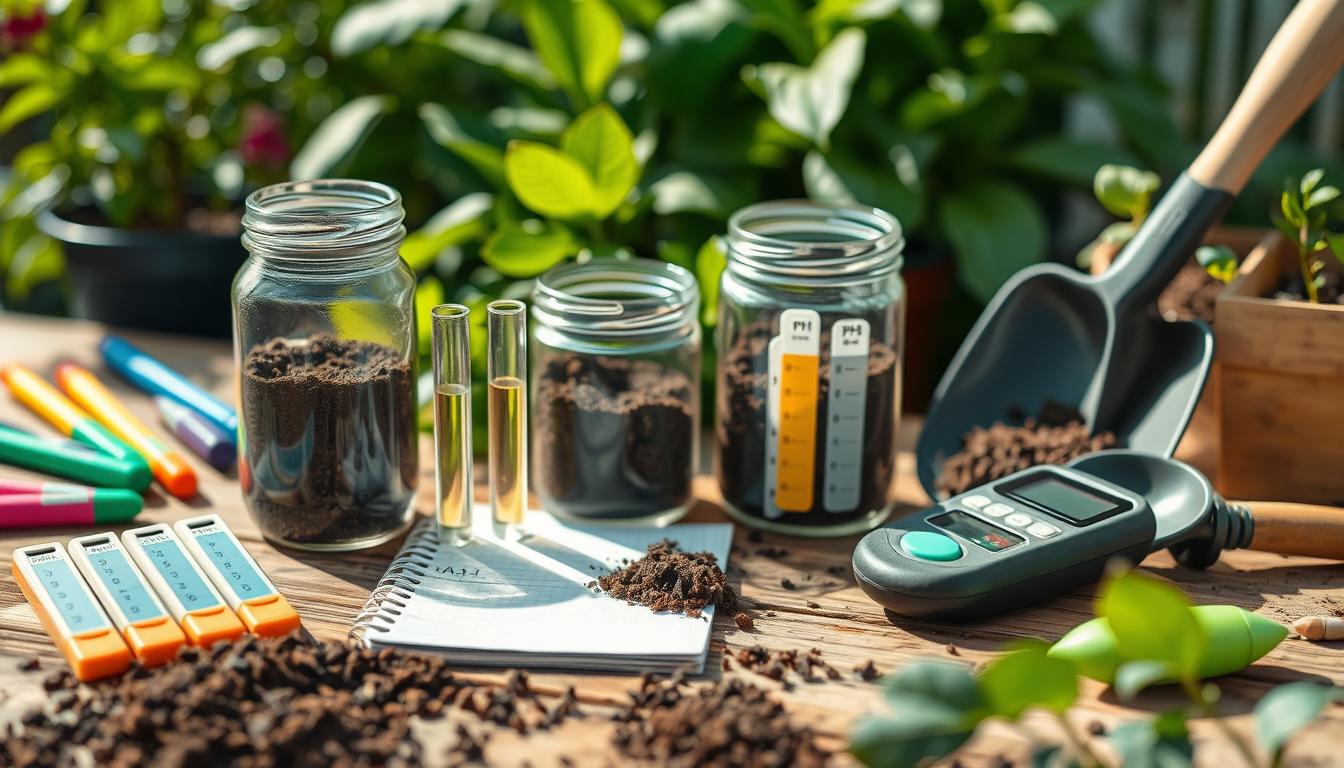As a gardener, I’ve found that testing my garden soil is key for healthy plants. To start, it’s important to know about soil testing methods. I’ll show you how to test your soil yourself, helping you pick the right fertilizers and amendments.
Testing your soil is easy with the right methods. You can find out what your soil is made of and its pH level. This info helps you choose the best ways to improve your garden, from DIY tests to more complex methods. By following these steps, you’ll make your soil better and grow a great garden.
In this article, I’ll share my own experiences with soil testing. I’ll also give tips and advice on how to improve your soil quality. This guide is for both new and experienced gardeners. It shows the importance of soil testing and how to use it to enhance your gardening.
Why Testing Garden Soil is Essential for Plant Health
As a gardener, I’ve learned that understanding the importance of soil testing is crucial for maintaining healthy plants. Soil testing for gardening helps me identify the nutrient content, pH, and structure of my soil. This is essential for making informed decisions about fertilizers, amendments, and other gardening practices.
The importance of soil testing cannot be overstated. By testing my soil, I can determine its pH level, which is critical for plant growth. Soil pH testing helps me understand whether my soil is acidic, alkaline, or neutral. I can then make adjustments accordingly.
Understanding Soil Composition
Soil composition is a complex mix of nutrients, minerals, and organic matter. Testing my soil helps me understand its composition. It also helps me identify potential deficiencies or imbalances.
Benefits of Soil Testing
The benefits of soil testing are numerous. It helps me optimize my gardening practices, reduce waste, and create a healthier environment for my plants to thrive.
Common Garden Problems Linked to Soil Quality
Many common garden problems, such as poor plant growth or increased pest activity, can be linked to soil quality. By testing my soil, I can identify these problems early on. I can then take corrective action to improve the health and productivity of my plants.
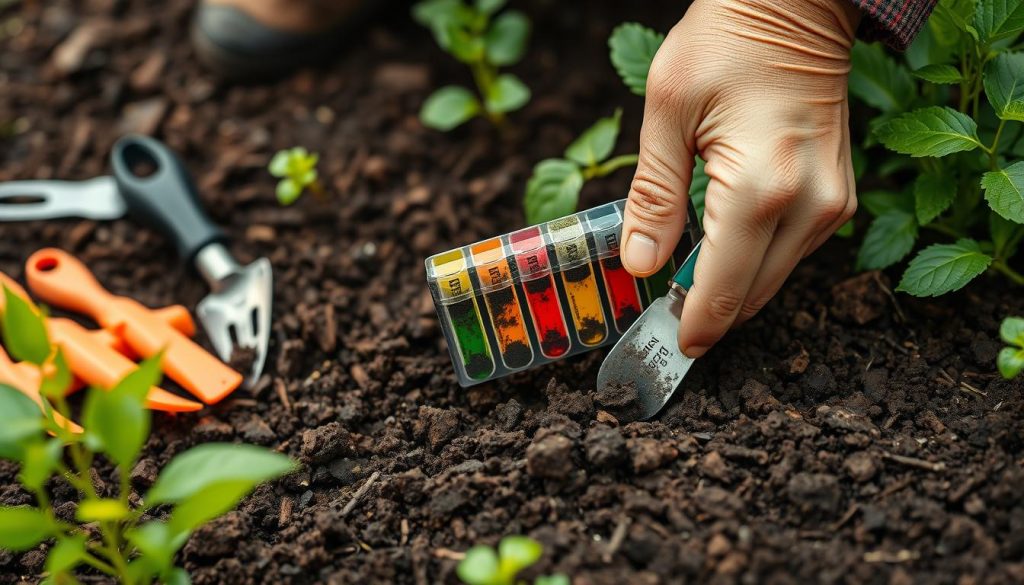
Types of Soil Tests Available
There are many ways to test your soil. You can pick from basic kits, professional services, or DIY methods. Each has its own benefits and drawbacks. The right choice depends on what you need and want.
Soil testing kits are easy and cheap. They check pH, nitrogen, phosphorus, and potassium levels. The best DIY kits give accurate results but might not be as detailed as professional tests.
Basic Soil Test Kits
Basic kits are perfect for those who want a quick soil check. They measure pH, nitrogen, phosphorus, and potassium. They’re cheap and easy to find online or at gardening stores.
Professional Soil Testing Services
For a detailed soil analysis, go for professional services. They test a lot, including pH, nutrients, and contaminants. Their results are more precise and can spot specific soil issues.
DIY Soil Testing Methods
DIY testing is fun and educational. It uses simple tools to measure pH and nutrients. While not as precise as pros, it still offers useful insights.
Some popular DIY methods include:
- Using a soil testing kit to measure pH and nutrient levels
- Conducting a simple soil texture test to determine the proportion of sand, silt, and clay in your soil
- Using a DIY soil testing kit to measure contaminants such as lead and mercury
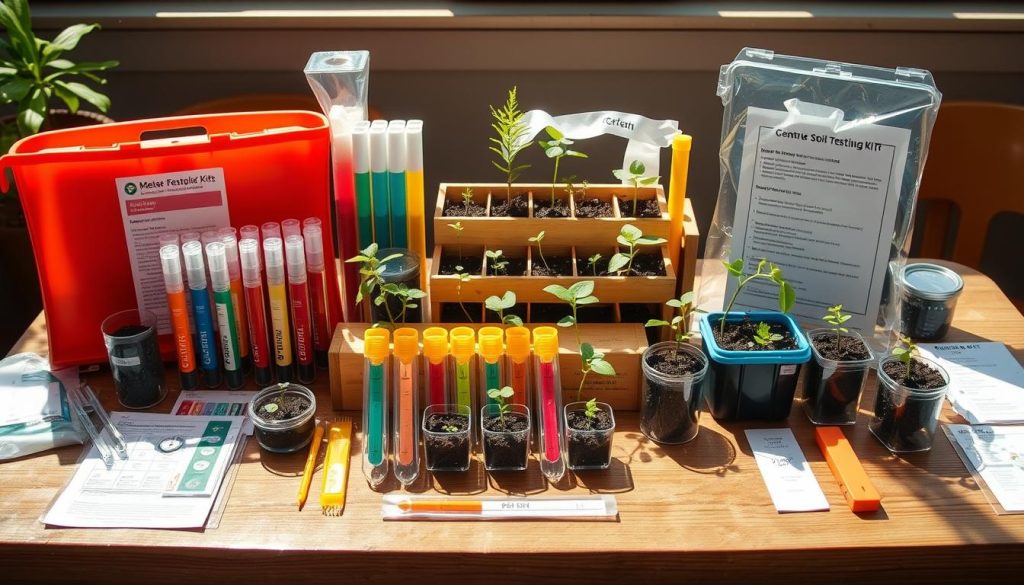
Choosing the right soil test helps you understand your soil better. Whether it’s a basic kit, professional service, or DIY, use the results to improve your soil’s health.
| Soil Test Type | Cost | Accuracy |
|---|---|---|
| Basic Soil Test Kit | Inexpensive | Good |
| Professional Soil Testing Service | More expensive | High |
| DIY Soil Testing Method | Low cost | Variable |
Understanding Soil pH and Its Importance
Soil pH is key to plant health and growth. Testing the soil pH helps gardeners know how to best care for their plants. Most plants do well in slightly acidic to neutral soil.
What is Soil pH?
Soil pH measures how acidic or alkaline the soil is. It ranges from 0 to 14, with 7 being neutral. Knowing your soil pH is vital for plant health.
How pH Influences Nutrient Availability
Soil pH affects how plants get nutrients. Different nutrients are best at different pH levels. So, it’s important to understand your soil pH for plant growth.
Ideal pH Levels for Common Garden Plants
Most garden plants like a slightly acidic to neutral soil pH, between 6.0 and 7.0. But, some like it more acidic, like azaleas and blueberries, which prefer a pH of about 5.5.
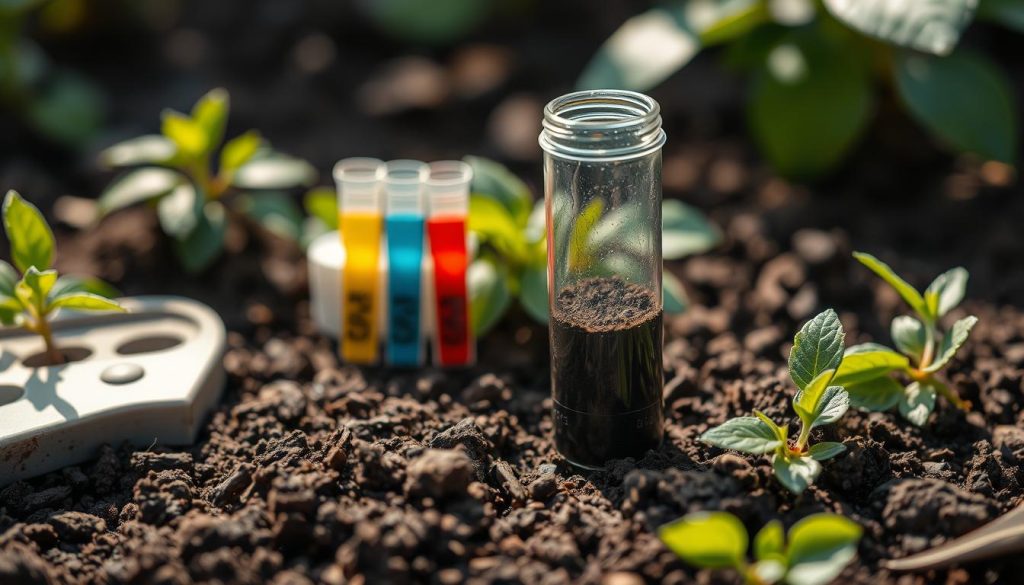
Knowing your soil pH and what plants prefer helps gardeners make better choices. This ensures plants grow well and are productive.
How to Collect a Soil Sample Properly
Collecting a soil sample is key to getting accurate results. It’s important to follow the right steps for effective soil sampling. The goal is to get a sample that truly represents your soil.
To collect a soil sample, you need to gather a small amount of soil from your garden or yard. This sample will then be analyzed at a lab. You’ll need a shovel or trowel and a clean container to store the sample.
Tools You’ll Need for Sampling
- A shovel or trowel for digging
- A clean container for storing the sample
- Gloves to handle the soil
Where to Take Samples From
It’s important to take samples from different spots in your garden or yard. This ensures the sample is a good representation of the area. Look for spots with different soil types, like clay, silt, or sand, and take samples from each.
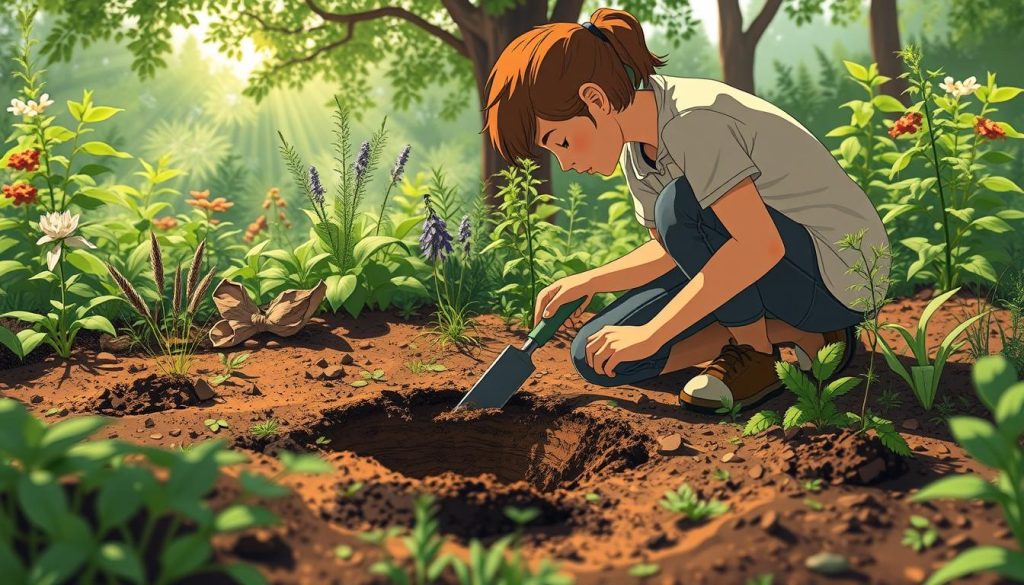
Tips for Effective Soil Sampling
To get a good soil sample, follow these tips: collect samples from various locations, avoid areas with standing water or debris, and handle the soil carefully to prevent contamination. By doing this and using the right tools, you can get a high-quality sample for accurate test results.
Analyzing Your Soil Sample
After collecting your soil sample, it’s time to analyze it. You’ll send it to a lab for testing. This will give you detailed results about your soil’s nutrients, pH, and structure.
These results are crucial for making gardening decisions. They help you know what fertilizers and amendments to use. This way, you can improve your soil and grow healthier plants.
Sending Samples to a Lab
To get accurate results, send your sample to a reputable lab. You can find these labs at your local cooperative extension office or online. Make sure to follow the lab’s instructions for packaging and shipping.
Interpreting Soil Test Results
When you get your results, take your time to review them. Look for information on nutrient levels, pH, and recommended amendments. This will help you plan to improve your soil’s quality.
Making Sense of Soil Amendments
Soil amendments can be confusing. But understanding them is key to improving your soil. Common amendments include compost, manure, and fertilizers. They help adjust pH, add nutrients, and improve structure.
Here are some key points to consider when analyzing your soil sample and using soil amendments:
- Soil analysis provides valuable information about your soil’s nutrient content, pH, and structure.
- Soil test results help you determine which soil amendments are necessary to optimize your soil’s quality and fertility.
- Using the right soil amendments can improve your soil’s pH, add nutrients, and enhance its overall structure.
By following these steps and using the right soil amendments, you can improve your soil’s quality. This leads to healthier plants and a more successful garden.
| Soil Amendment | Purpose | Benefits |
|---|---|---|
| Compost | Adds organic matter and nutrients | Improves soil structure, increases fertility |
| Manure | Provides nutrients and microorganisms | Enhances soil fertility, supports healthy microbial activity |
| Fertilizers | Supplies essential nutrients | Promotes plant growth, increases crop yields |
How to Test Soil for Nutrient Levels
Testing your soil’s nutrient levels is key to your plants’ health and growth. Knowing what nutrients your soil lacks helps you choose the right fertilizers. To find out, you need to collect a soil sample and send it to a lab for analysis.
Getting an accurate reading starts with a good soil sample. You should mix samples from different parts of your garden. Then, send it to a lab for a detailed report on your soil’s nutrient levels.
Key Nutrients to Test For
Soil nutrient testing focuses on nitrogen, phosphorus, and potassium. These nutrients are vital for plant growth. A lack in any can harm your plants’ health and productivity.
Testing for Nitrogen, Phosphorus, and Potassium
Testing these nutrients involves analyzing your soil sample. Methods like spectroscopy and chromatography are used. The results show you what nutrients your soil lacks and in what amounts.
Interpreting Nutrient Deficiency Signs
After getting your test results, you can spot nutrient deficiencies. Look for yellow leaves, stunted growth, or poor fruiting. Knowing these signs helps you fix any nutrient issues and boost your plants’ health and growth.
Dealing with Soil Compaction
Soil compaction is a big problem in gardens, especially where lots of people walk or water often. It happens when the soil gets squished, making it hard for roots to grow and water to get in. This can hurt plant health and make them grow less well.
To fix soil compaction, first spot the signs. Look for poor drainage, plants that don’t grow well, and water running off too fast. Then, you can try a few things to loosen the soil:
- Adding organic matter like compost or manure
- Using a fork or aerator to loosen the soil
- Applying mulch to reduce soil compression
Benefits of Soil Aeration
Soil aeration is key to better soil and less compaction. It lets water soak in better, stops soil from washing away, and helps roots grow strong. This makes plants healthier, grow more, and keeps your garden eco-friendly.
Knowing why soil gets compacted and how to fix it helps your plants thrive. Regular aeration and care stop compaction, making your garden healthy and productive.
| Method | Benefits |
|---|---|
| Adding organic matter | Improves soil structure, increases water infiltration |
| Using a fork or aerator | Loosens compact soil, promotes root growth |
| Applying mulch | Reduces soil compression, retains moisture |
Amending Soil to Improve Quality
Improving your soil quality is key to better gardening. Knowing about different amendments helps you create a healthy soil environment. These amendments can make your soil better for plants to grow.
Adding organic matter is a top way to improve soil. This includes compost, manure, or peat moss. It makes the soil better at holding water and nutrients for plants. It’s also important to balance soil nutrients for plant growth.
Common Amendments and Their Uses
- Compost: rich in nutrients, improves soil structure
- Manure: high in nutrients, supports microbial activity
- Peat moss: acidifies soil, improves water-holding capacity
How to Incorporate Organic Matter
To add organic matter, start with a 2-3 inch layer of compost or manure on top. Mix it well into the soil and water it well. You can also add peat moss to improve soil structure and water retention.
Tips for Balancing Soil Nutrients
Testing your soil regularly is crucial for nutrient balance. It helps spot any missing nutrients and fix them. You can use amendments to adjust the soil’s pH and add essential nutrients for plants.
| Soil Amendment | Nutrient Provided | pH Level |
|---|---|---|
| Compost | Nitrogen, Phosphorus, Potassium | Neutral |
| Manure | Nitrogen, Phosphorus, Potassium | Neutral |
| Peat Moss | None | Acidic |
The Importance of Soil Microorganisms
Soil microorganisms are key to keeping soil healthy. They break down organic matter, fix nitrogen, and make minerals available. Knowing their role helps you create a soil environment that supports plant growth.
A healthy soil needs beneficial microbes. These microbes help break down organic matter, fight diseases, and cycle nutrients. To support them, ensure your soil has enough moisture, organic matter, and nutrients.
Benefits of Soil Microorganisms
- Improve soil structure and fertility
- Enhance nutrient availability and uptake
- Suppress soil-borne diseases and pests
- Promote plant growth and development
By supporting soil microorganisms, you can boost soil health. This leads to a productive and sustainable garden. Use organic matter, compost, and avoid chemicals to help.
Regular Soil Testing: A Best Practice
As a gardener, I’ve learned how key regular soil testing is. It helps keep my soil healthy and productive. By testing it often, I catch problems early and fix them. This ensures my garden stays healthy and productive over time.
To figure out how often to test your soil, think about a few things:
- Type of plants being grown
- Climate and weather conditions
- Soil type and composition
Frequency for Testing Your Soil
How often you should test your soil varies. It depends on your plants, climate, and soil type. Generally, test your soil once a year. But, you might need to do it more often in some cases.
Seasonal Considerations
Seasons also affect when to test your soil. For example, in rainy areas, you might need to test more often. This helps prevent soil from becoming too acidic or alkaline.
Long-term Benefits of Regular Testing
Regular soil testing offers many benefits. It improves soil health, boosts crop yields, and helps the environment. By making it a regular part of gardening, you ensure your garden’s long-term health.
| Soil Testing Frequency | Recommended Testing Schedule |
|---|---|
| Annual Testing | Test soil once a year, ideally in the spring or fall |
| Bi-Annual Testing | Test soil every 6 months, ideally in the spring and fall |
Learning from Your Soil Test Results
After getting your soil test results, it’s key to know how to use them. This helps improve your garden plan. By looking at your results, you can spot areas to work on. You can then decide on the right fertilizers, soil fixes, and gardening methods.
To make your garden better, you need to act on what you learn. This might mean changing how you use fertilizers or adding organic stuff to the soil. These steps help make your soil healthier. This, in turn, makes your plants grow better and your garden more successful.
Adapting Your Garden Strategy
To change your garden plan, follow these steps:
- Look at your soil test results to find out what’s missing or off balance
- Find and pick the right fertilizers or soil fixes for these problems
- Plan to add organic stuff like compost or manure to make the soil better
Implementing Findings for Better Growth
It’s important to put your plan into action for better growth. This means using fertilizers, adding soil fixes, or trying new gardening ways. By always improving and checking your soil, you can make your garden even better.
Embracing Continuous Improvement
Improving your garden is key to long-term success. By testing your soil often and adjusting your plan, you can avoid problems. Remember, learning from your soil tests is a journey. It takes patience, hard work, and a desire to keep getting better.
| Soil Test Results | Garden Strategy | Continuous Improvement |
|---|---|---|
| Nutrient deficiencies | Adjust fertilizer application | Regularly monitor soil test results |
| Soil pH imbalances | Apply soil amendments | Refine garden strategy based on test results |
| Soil structure issues | Add organic matter | Stay up-to-date with latest gardening techniques |
My Personal Experience with Soil Testing
When I started gardening, I was scared of soil testing. I thought it was too much work and my plants would grow anyway. But, dealing with weak plants and nutrient issues made me see how crucial it is to know your soil.
Initial Challenges I Faced
Getting my first soil sample was tough. I didn’t know where to start or how to understand the results. But, when I got them, I was amazed at how much they told me about my soil.
How I Improved My Soil Quality
With the test results, I knew exactly what my garden needed. I added organic matter, adjusted the pH, and fixed nutrient gaps. Soon, my plants were healthier, stronger, and more productive.
Final Thoughts on the Process
Soil testing is now a key part of my gardening. It helps me fix problems and keep my soil healthy for the long run. I recommend it to all gardeners. It’s a small investment for big garden benefits.

